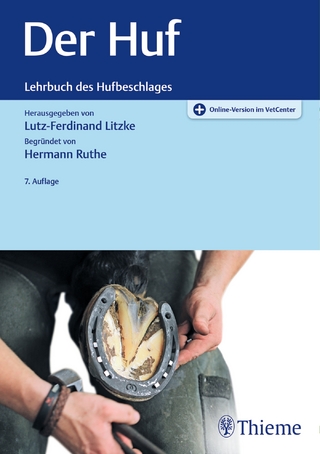
Laboratory Procedures for Veterinary Technicians
Mosby (Verlag)
978-0-323-59538-4 (ISBN)
Comprehensive coverage gives you a solid foundation in the fundamentals of microbiology, hematology, urinalysis, immunology, and cytology, along with the laboratory procedures used to perform related tests.
Provides the latest information needed to successfully perform a broad spectrum of laboratory tests, including complete blood count, urinalysis, and immunologic assays.
Step-by-step procedure boxes offer quick access to the skills you must perform during your educational program, as well as procedures that are commonly performed by vet techs in private practice.
A comprehensive glossary of terms at the end of the text offers accurate, concise definitions.
Vet Tech Threads provide you with introductions, suggested readings, boxed technician notes, learning objectives, chapter outlines, key terms, and a glossary for easy navigation through chapters and more focused learning.
NEW! Completely updated content throughout reflects the latest advances in veterinary clinical laboratory procedures for improved patient service and higher practice revenue.
NEW! Thoroughly updated and expanded Quality Control and Record Keeping chapter ensures you have the most current information in this vital area.
UPDATED! Immunology section includes the latest information in this fast-growing veterinary technology area.
Margi Sirois is certified as both a veterinary technician & laboratory animal technician and has over 25 years of experience as a veterinary technician educator in both traditional and distance education programs. She is a past-president of the Association of Veterinary Technician Educators and the Kansas Veterinary Technician Association and co-founder and current president of the Academy of Veterinary Technician Specialists in Education
UNIT 1: THE VETERINARY PRACTICE LABORATORY 1. Safety and OSHA Standards 2. General Laboratory Equipment 3. The Microscope 4. The Metric System and Lab Calculations 5. Quality Control and Record Keeping (UPDATED!)
UNIT 2: HEMATOLOGY 6. Hematopoeisis 7. Sample Collection and Handling 8. Automated Analyzers 9. Hemoglobin, PCV, and Erythrocyte Indices 10. Evaluating the Blood Film 11. Morphologic Abnormalities of Blood Cells 12. Additional Hematologic Tests 13. Hematopoeitic Disorders and Classification of Anemia
UNIT 3: HEMOSTASIS 14. Principles of Blood Coagulation 15. Sample Collection and Handling 16. Platelet Evaluation 17. Coagulation Testing 18. Disorders of Hemostasis
UNIT 4: IMMUNOLOGY (ENTIRE UNIT UPDATED!) 19. Basic Principles of Immunology 20. Common Tests Performed in the In-House Testing 21. Blood Groups and Immunity 22. Intradermal Testing 23. Reference Laboratory Tests 24. Disorders of the Immune System
UNIT 5: URINALYSIS 25. Anatomy and Physiology of the Urinary System 26. Sample Collection and Handling 27. Physical Examination of Urine 28. Chemical Evaluation 29. Urine Sediment Analysis
UNIT 6: CLINICAL CHEMISTRY 30. Sample Collection and Handling 31. Automated Analyzers 32. Protein Assays and Hepatobiliary Function Tests 33. Kidney Function Tests 34. Pancreatic Function Tests 35. Electrolyte and Acid-Base Status 36. Miscellaneous Tests
UNIT 7: MICROBIOLOGY 37. Introduction to Microbiology 38. Equipment and Supplies 39. Sample Collection and Handling 40. Staining Specimens 41. Culture Techniques 42. Antimicrobial Sensitivity Testing 43. Additional Testing 44. Mycology
UNIT 8: PARASITOLOGY 45. Nematodes 46. Cestodes, Trematodes, and Acantocephelans 47. Protozoa and Rickettsia 48. Arthropods 49. Sample Collection and Handling 50. Diagnostic Techniques
UNIT 9: CYTOLOGY 51. Sample Collection and Handling 52. Preparation of Cytology Smears 53. Microscopic Evaluation 54. Cytology of Specific Sites
Appendix A: Chapter Review Questions by Unit
Appendix B: Reference Ranges Appendix C: Bacterial Pathogens of Veterinary Importance Appendix D: Professional Associations Related to Veterinary Clinical Laboratory Diagnostics Appendix E: Common Parasites of Some Exotic Animal Species
| Erscheinungsdatum | 26.02.2019 |
|---|---|
| Zusatzinfo | 485 illustrations (485 in full color); Illustrations |
| Verlagsort | St Louis |
| Sprache | englisch |
| Maße | 216 x 276 mm |
| Gewicht | 1220 g |
| Themenwelt | Veterinärmedizin ► Allgemein ► Tiermedizinische Fachangestellte |
| ISBN-10 | 0-323-59538-3 / 0323595383 |
| ISBN-13 | 978-0-323-59538-4 / 9780323595384 |
| Zustand | Neuware |
| Informationen gemäß Produktsicherheitsverordnung (GPSR) | |
| Haben Sie eine Frage zum Produkt? |
aus dem Bereich



